Cerebellar zones: a personal history
- PMID: 20967577
- PMCID: PMC3169774
- DOI: 10.1007/s12311-010-0221-6
Cerebellar zones: a personal history
Abstract
Cerebellar zones were there, of course, before anyone noticed them. Their history is that of young people, unhindered by preconceived ideas, who followed up their observations with available or new techniques. In the 1960s of the last century, the circumstances were fortunate because three groups, in Leiden, Lund, and Bristol, using different approaches, stumbled on the same zonal pattern in the cerebellum of the cat. In Leiden, the Häggqvist myelin stain divulged the compartments in the cerebellar white matter that channel the afferent and efferent connections of the zones. In Lund, the spino-olivocerebellar pathways activated from individual spinal funiculi revealed the zonal pattern. In Bristol, charting the axon reflex of olivocerebellar climbing fibers on the surface of the cerebellum resulted in a very similar zonal map. The history of the zones is one of accidents and purposeful pursuit. The technicians, librarians, animal caretakers, students, secretaries, and medical illustrators who made it possible remain unnamed, but their contributions certainly should be acknowledged.
Figures




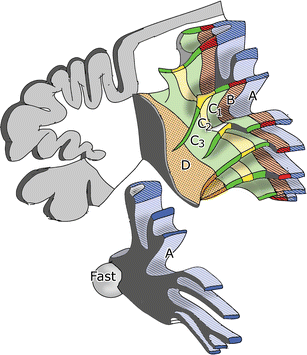

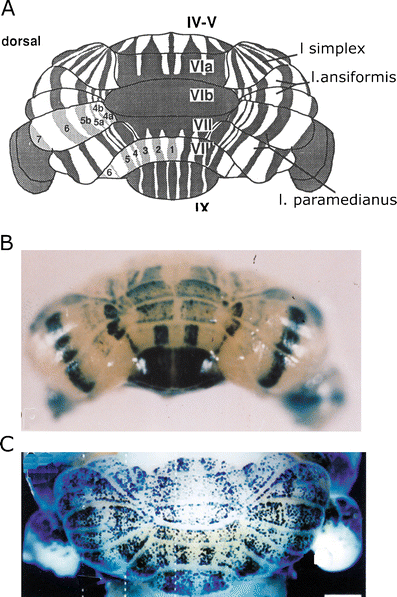




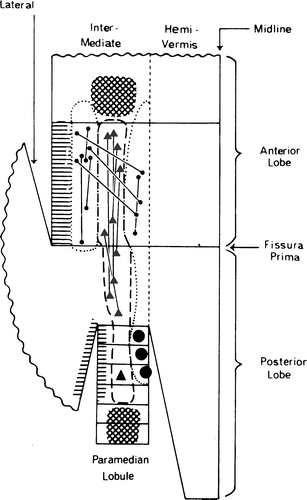
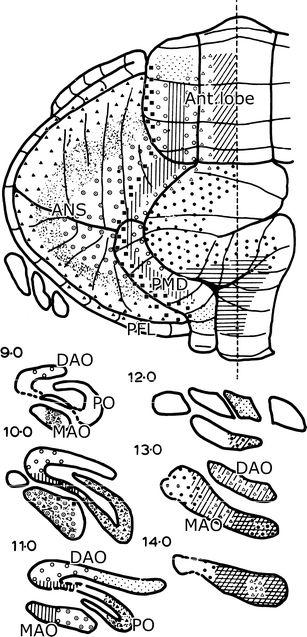
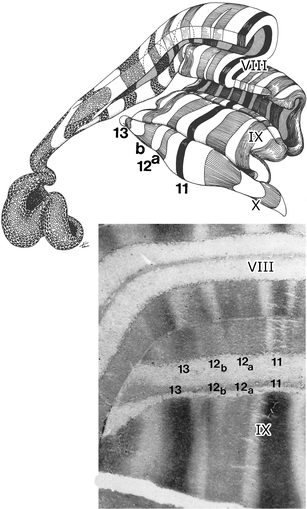


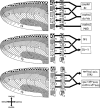
Similar articles
-
Afferents to the cerebellar cortex in the cat: evidence for an intrinsic pathway leading from the deep nuclei to the cortex. 1976.Cerebellum. 2010 Mar;9(1):1-13. Cerebellum. 2010. PMID: 20336815 No abstract available.
-
Commentary of "Brown Gould B, Graybiel AM. Afferents to the cerebellar cortex in the cat: evidence for an intrinsic pathway leading from the deep nuclei to the cortex. Brain Research 1976;110:601-611".Cerebellum. 2010 Mar;9(1):14-6. doi: 10.1007/s12311-009-0135-3. Cerebellum. 2010. PMID: 19841996 No abstract available.
-
Zones in the cerebellar cortex: the adventures of one participant in the unfolding story.Cerebellum. 2011 Sep;10(3):351-5. doi: 10.1007/s12311-011-0304-z. Cerebellum. 2011. PMID: 21809100
-
Movement-related gating of climbing fibre input to cerebellar cortical zones.Prog Neurobiol. 1999 Apr;57(5):537-62. doi: 10.1016/s0301-0082(98)00068-9. Prog Neurobiol. 1999. PMID: 10215101 Review.
-
Cerebellar afferent systems: a review.Prog Neurobiol. 1973;2(1):3-68. doi: 10.1016/0301-0082(73)90006-3. Prog Neurobiol. 1973. PMID: 4598179 Review. No abstract available.
Cited by
-
Exploration and Identification of Cortico-Cerebellar-Brainstem Closed Loop During a Motivational-Motor Task: an fMRI Study.Cerebellum. 2017 Apr;16(2):326-339. doi: 10.1007/s12311-016-0801-1. Cerebellum. 2017. PMID: 27271710
-
Lobule-Related Action Potential Shape- and History-Dependent Current Integration in Purkinje Cells of Adult and Developing Mice.Cells. 2023 Feb 15;12(4):623. doi: 10.3390/cells12040623. Cells. 2023. PMID: 36831290 Free PMC article.
-
Cerebellar Modules and Their Role as Operational Cerebellar Processing Units: A Consensus paper [corrected].Cerebellum. 2018 Oct;17(5):654-682. doi: 10.1007/s12311-018-0952-3. Cerebellum. 2018. PMID: 29876802 Free PMC article. Review.
-
Cellular commitment in the developing cerebellum.Front Cell Neurosci. 2015 Jan 12;8:450. doi: 10.3389/fncel.2014.00450. eCollection 2014. Front Cell Neurosci. 2015. PMID: 25628535 Free PMC article. Review.
-
A note on the definition and the development of cerebellar Purkinje cell zones.Cerebellum. 2012 Jun;11(2):422-5. doi: 10.1007/s12311-012-0367-5. Cerebellum. 2012. PMID: 22396330 Free PMC article. Review.
References
-
- Alzheimer A. Beiträge zur Kenntnis der pathologischen Glia und ihrer Beziehungen zu den Abbauprodukten im Nervengewebe. Histologische und histopathologische Arbeiten über die Grosshirnrinde, vol. 3. 1910. p. 3.
-
- Romeis B. Mikroskipische Technik. München: Ildenburg; 1948.
-
- Blum F. Der Formaldehyd als Härtungsmittel. Zeitschrift für wissneschaftliche Mikroskopie. 1896;10:314.
-
- Häggqvist Analyse der Faserverteilung in einem Rückenmarkquerschnitt. Z Mikr Anat Forschung. 1936;39:1–34.
-
- Mechelse K. De vezelstructuur van de capsula interna en pedunculus cerebri bij Macaca ira. Thesis, Leiden; 1953.
Publication types
MeSH terms
LinkOut - more resources
Full Text Sources
Miscellaneous

